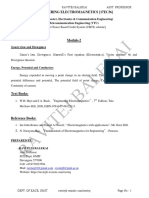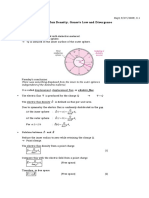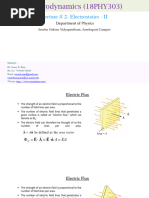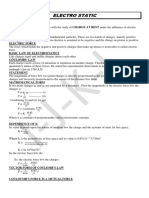Chapter 3
Uploaded by
Pratik JariwalaChapter 3
Uploaded by
Pratik JariwalaTechno Tutor 2010
Er. Pratik Jariwala Mob. No. : 09327315344 Resi. No. : 0261-2770565
Techno Tutor
(Tuition for Engineering)
CHAPTER 3 : Electric Flux Density, Gausss Law, Divergence & The Divergence Theorem
3.1 : Concept of Electric Flux
Fig. shows a concentric metallic sphere of radius Suppose a positive charge Q is given to this sphere. Then this sphere is enclosed by another concentric metallic sphere of radius b (b>a) as shown in fig. This outer sphere is in the form of to hemispheres. Between these two spheres, a dielectric material is present. The outer sphere is discharged by connecting it momentarily to ground. Then the charge on the outer sphere is measured carefully.
Metal conducting sphere
which forms the inner sphere.
Insulating dielectric material
This is found that the charge on the outer sphere is equal in magnitude to the charge on the inner sphere but opposite in the sign.
Page 1
Techno Tutor 2010
Hence there is a sort of displacement from the inner sphere to the outer sphere which is independent of the medium between two spheres and this is known as displacement of flux or electric flux. Electric flux is denoted by and has the unit Coulomb (C). =Q = flux leaving through a closed surface = charged enclosed by the closed surface = Q
3.2 : Electric Flux Density and Its Relationship With Electric Field Intensity
Fig. (a) shows the flux lines due to some charge distribution. At point P consider a differential area dS to which is perpendicular. Also in the neighbourhood of point P the lines of flux are in the same direction as that of . Then electric flux density is defined as the number flux lines crossing a surface per unit area. It is a vector quantity denoted by . Hence where d is the amount of flux leaving through the area dS. With reference to fig. (b) consider a + Q C charge at the origin of the coordinate system. Let point P (r, , ) lies on the spherical surface of radius r. Then at point P
Page 2
Techno Tutor 2010
= =
and = = = = , where is the relative
Hence = for free space. In general permittivity of the medium.
3.3 : Gausss Law as Applied to Electric Flux Density :
The generalisations of Faradays experiment lead to the following statement, which is known as Gausss law. The electric flux passing through any closed surface is equal to the total charge enclosed by that surface. Let us consider a distribution of charge shown as a cloud of do not charge in the fig. surrounded by a closed surface of any shape.
NORMAL
If the total charge is Q, then Q coulombs of electric flux will pass through the enclosing surface. At every point on the surface the electric flux density vector will have some value . Let at point P, is a unit vector normal to differential area S located at point P. Then = S and makes an angle with at point P. Then
Page 3
Techno Tutor 2010
= flux crossing = = = =
and the total flux is given by = =
Thus the mathematical formation of Gausss law is
3.4 : Expression for Divergence of :
Z
P
Z X Y Y
Let us consider a small differential volume element in the form of a rectangular box centred at the point P ( , , ) in cartesian coordinate system as shown in fig. The edges are parallel to axes with lengths x, y and Apply Gausss law to this closed surface z.
The left hand side is broken up into six integrals,
Page 4
Techno Tutor 2010
Since the surface element is very small, is essentially constant and
( )=
expand around the point
To determine
(
+
) by using Taylors
series and neglect higher order terms. = at point P is equal = at point P ( , , )
(
+
)=
+
where
is the value of
..
Similarly =
)
( )
( (
+
)= )
..
Adding these integrals we get Similarly
Page 5
Techno Tutor 2010
And
And these results may be collected to yields = Q =
+
=
Volume enclosed by rectangular box = Hence = Q =
)
shrink to zero
Dividing the above expression by
and taking the limit as
Now the divergence of the vector flux density is defined as the outflow of flux from a small closed surface per unit volume shrinks to zero. Divergence of = div = Hence we have div =
3.5 : Maxwells First Equation In Electrostatics:
According to Gausss law
Dividing both side of above equation by v, and take the limit as the volume shrinks to zero, we have
Page 6
Techno Tutor 2010
Now the volume charge density is defined as
And divergence of electric flux density by Hence we have . This is Maxwells first equation in electrostatics. It states that The electric flux per unit volume charge density, there. This equation is the point form of Gausss law. The del operator is defined only in cartesian coordinate system by the equation. = Let = Then , + = + .
+ +
) ( =
Which is same as div . Hence = div =
Page 7
Techno Tutor 2010 3.6 : State And Prove Divergence Theorem :
According to Gausss law And from the definition of volume charge density, we have And from Maxwells first equation in electrostatics, we have = Hence
From the first and last expressions we have
which is the divergence theorem. It states that The integral of the normal components of any vector field over a closed surface is equal to the divergence of this vector field throughout the volume enclosed by the closed surface.
Page 8
You might also like
- Mechanical Drives 2 Portfolio AssessmentNo ratings yetMechanical Drives 2 Portfolio Assessment97 pages
- Locomotor Movements & Non-Locomotor Movements100% (1)Locomotor Movements & Non-Locomotor Movements6 pages
- Electromagnetic Fields: Lecture 4: Electric Flux Density, Gausss Law, and DivergenceNo ratings yetElectromagnetic Fields: Lecture 4: Electric Flux Density, Gausss Law, and Divergence20 pages
- Electricity and Magnetism: Prof. Dr. Hatem ElhennawiNo ratings yetElectricity and Magnetism: Prof. Dr. Hatem Elhennawi19 pages
- Electric Flux Density, Gauss's Law, and DivergenceNo ratings yetElectric Flux Density, Gauss's Law, and Divergence40 pages
- FT_160990109003_Electric Flux Density, Gauss’s Law, and DivergenceNo ratings yetFT_160990109003_Electric Flux Density, Gauss’s Law, and Divergence29 pages
- Chapter 6 Introduction To ElectromagnetismNo ratings yetChapter 6 Introduction To Electromagnetism18 pages
- Lec #2 - Electrostatics-II 18PHY303 ElectrodynamicsNo ratings yetLec #2 - Electrostatics-II 18PHY303 Electrodynamics35 pages
- Module 1 ELECTRIC FLUX & GAUSS LAW-BALAJINo ratings yetModule 1 ELECTRIC FLUX & GAUSS LAW-BALAJI46 pages
- Electromagnetism I: Electrostatics: 1 Coulomb's Law and Gauss's LawNo ratings yetElectromagnetism I: Electrostatics: 1 Coulomb's Law and Gauss's Law17 pages
- PHY103A: Lecture # 4: Semester II, 2017-18 Department of Physics, IIT KanpurNo ratings yetPHY103A: Lecture # 4: Semester II, 2017-18 Department of Physics, IIT Kanpur19 pages
- 4.1 Electric Flux Lines and Flux Density: TopicsNo ratings yet4.1 Electric Flux Lines and Flux Density: Topics9 pages
- Chapter3 - Electric Flux Density, Gauss's Law, and DivergenceNo ratings yetChapter3 - Electric Flux Density, Gauss's Law, and Divergence23 pages
- Gauss Law - Applications, Derivation, Problems On Gauss TheoremNo ratings yetGauss Law - Applications, Derivation, Problems On Gauss Theorem1 page
- Electromagnetism I: Electrostatics: 1 Coulomb's Law and Gauss's LawNo ratings yetElectromagnetism I: Electrostatics: 1 Coulomb's Law and Gauss's Law18 pages
- Electromagnetic Wave Theory: Course Code:EC2102-1 Credits: 3No ratings yetElectromagnetic Wave Theory: Course Code:EC2102-1 Credits: 379 pages
- Chapter 2.2 - ฟลักซ์ไฟฟ้าและกฏของเกาส์ PPNo ratings yetChapter 2.2 - ฟลักซ์ไฟฟ้าและกฏของเกาส์ PP23 pages
- Module 4 - Maxwell Equations and EM WavesNo ratings yetModule 4 - Maxwell Equations and EM Waves18 pages
- Problems in Quantum Mechanics: Third EditionFrom EverandProblems in Quantum Mechanics: Third EditionD. ter Haar3/5 (2)
- Feynman Lectures Simplified 2B: Magnetism & ElectrodynamicsFrom EverandFeynman Lectures Simplified 2B: Magnetism & ElectrodynamicsNo ratings yet
- Name Hareem Fatima Roll Num El-021 Section D Second Year Electronics Im PresentationNo ratings yetName Hareem Fatima Roll Num El-021 Section D Second Year Electronics Im Presentation4 pages
- 9700 - 52 Biology - Question Paper June 2020No ratings yet9700 - 52 Biology - Question Paper June 20205 pages
- Crystallization From The Amorphous State: Nucleation-Growth Decoupling, Polymorphism Interplay, and The Role of InterfacesNo ratings yetCrystallization From The Amorphous State: Nucleation-Growth Decoupling, Polymorphism Interplay, and The Role of Interfaces14 pages
- Three-Phase Unbalance and Voltage Monitor Circuit US5369541No ratings yetThree-Phase Unbalance and Voltage Monitor Circuit US536954110 pages
- Top Oil Heat Distribution Pattern of ONAN Corn Oil BasedNo ratings yetTop Oil Heat Distribution Pattern of ONAN Corn Oil Based8 pages
- Operators Manual ASCO 7000 SERIES Automatic & Bypass Isolation Transfer Switch (ATB) 600-1200 Amps H & P FrameNo ratings yetOperators Manual ASCO 7000 SERIES Automatic & Bypass Isolation Transfer Switch (ATB) 600-1200 Amps H & P Frame16 pages
- Motion in A Straight Line: Distance, Displacement, Speed and VelocityNo ratings yetMotion in A Straight Line: Distance, Displacement, Speed and Velocity6 pages
- Ce 312A Engineering Utilities 2: College of Engineering Civil Engineering DepartmentNo ratings yetCe 312A Engineering Utilities 2: College of Engineering Civil Engineering Department2 pages
- Inspection and Test Plan (Towers & Fasteners) : DescriptionNo ratings yetInspection and Test Plan (Towers & Fasteners) : Description84 pages
- (ZNSHINE) Datasheet - (560W-585W) ZXMR-UHLD132No ratings yet(ZNSHINE) Datasheet - (560W-585W) ZXMR-UHLD1322 pages
- Farmacopeea Europeana Ed. 10 Cap. 2. 2. 29.100% (1)Farmacopeea Europeana Ed. 10 Cap. 2. 2. 29.2 pages
- Electromagnetic Fields: Lecture 4: Electric Flux Density, Gausss Law, and DivergenceElectromagnetic Fields: Lecture 4: Electric Flux Density, Gausss Law, and Divergence
- Electricity and Magnetism: Prof. Dr. Hatem ElhennawiElectricity and Magnetism: Prof. Dr. Hatem Elhennawi
- Electric Flux Density, Gauss's Law, and DivergenceElectric Flux Density, Gauss's Law, and Divergence
- FT_160990109003_Electric Flux Density, Gauss’s Law, and DivergenceFT_160990109003_Electric Flux Density, Gauss’s Law, and Divergence
- Lec #2 - Electrostatics-II 18PHY303 ElectrodynamicsLec #2 - Electrostatics-II 18PHY303 Electrodynamics
- Electromagnetism I: Electrostatics: 1 Coulomb's Law and Gauss's LawElectromagnetism I: Electrostatics: 1 Coulomb's Law and Gauss's Law
- PHY103A: Lecture # 4: Semester II, 2017-18 Department of Physics, IIT KanpurPHY103A: Lecture # 4: Semester II, 2017-18 Department of Physics, IIT Kanpur
- Chapter3 - Electric Flux Density, Gauss's Law, and DivergenceChapter3 - Electric Flux Density, Gauss's Law, and Divergence
- Gauss Law - Applications, Derivation, Problems On Gauss TheoremGauss Law - Applications, Derivation, Problems On Gauss Theorem
- Electromagnetism I: Electrostatics: 1 Coulomb's Law and Gauss's LawElectromagnetism I: Electrostatics: 1 Coulomb's Law and Gauss's Law
- Electromagnetic Wave Theory: Course Code:EC2102-1 Credits: 3Electromagnetic Wave Theory: Course Code:EC2102-1 Credits: 3
- Problems in Quantum Mechanics: Third EditionFrom EverandProblems in Quantum Mechanics: Third Edition
- Feynman Lectures Simplified 2B: Magnetism & ElectrodynamicsFrom EverandFeynman Lectures Simplified 2B: Magnetism & Electrodynamics
- Name Hareem Fatima Roll Num El-021 Section D Second Year Electronics Im PresentationName Hareem Fatima Roll Num El-021 Section D Second Year Electronics Im Presentation
- Crystallization From The Amorphous State: Nucleation-Growth Decoupling, Polymorphism Interplay, and The Role of InterfacesCrystallization From The Amorphous State: Nucleation-Growth Decoupling, Polymorphism Interplay, and The Role of Interfaces
- Three-Phase Unbalance and Voltage Monitor Circuit US5369541Three-Phase Unbalance and Voltage Monitor Circuit US5369541
- Top Oil Heat Distribution Pattern of ONAN Corn Oil BasedTop Oil Heat Distribution Pattern of ONAN Corn Oil Based
- Operators Manual ASCO 7000 SERIES Automatic & Bypass Isolation Transfer Switch (ATB) 600-1200 Amps H & P FrameOperators Manual ASCO 7000 SERIES Automatic & Bypass Isolation Transfer Switch (ATB) 600-1200 Amps H & P Frame
- Motion in A Straight Line: Distance, Displacement, Speed and VelocityMotion in A Straight Line: Distance, Displacement, Speed and Velocity
- Ce 312A Engineering Utilities 2: College of Engineering Civil Engineering DepartmentCe 312A Engineering Utilities 2: College of Engineering Civil Engineering Department
- Inspection and Test Plan (Towers & Fasteners) : DescriptionInspection and Test Plan (Towers & Fasteners) : Description

























































































